I’m due over to see Brian Bicknell, industry legend, and now owner of Mahi wines in Marlborough at the end of the day, for a tasting at the winery. When I’m going about my day, people ask what I’m up to, and I tell them who I’m seeing that day and the next. And everyone – and I mean everyone – says “say Hello to Brian from me”
Brian Bicknell: I’m a bit of a wine tragic and one of the many things I love about wine is the people. Now, I’ve got a few wines and you would have covered a bit of ground today, and I know it’s not your first visit – you were in the Awatere last time weren’t you? Well, our vineyards are up this end of the Wairau valley and you do get massive differences in characters. When I got here from Chile, there were no vineyards down the other end. And they’re much more fertile, warmer, giving different fruit characters. More thiol-y in general, and bigger crops. Expensive land. It’s now $350K a hectare. But as you come up this way it’s a bit more citric and we’ve chosen vineyards up this end of the valley, really aiming to get nice acidity and a bit more citric. It all comes down to personal style – another of the great things of wine – and I’m not big on thiols, so we don’t aim for that style. Right from the start we made wines in a different style. We don’t want to make big fruit-bomb styles.
We’re small, don’t do supermarkets, but we do export to 15 countries. We want to make wines that obviously we enjoy, and are a bit more subtle with a longer palate. Our Sauvignon is a pretty good example for us. Six vineyards, predominately down here and then one down at Ward – our coolest vineyard. Three of them we hand-pick because we want to get it away from the skins. We put the fruit over a sorting table and anything we don’t like we compost. And then we whole-cluster press. Press it, the berries pop like caviar and the juice runs away, so it doesn’t sit on skins.
The bit that we machine pick, we machine to bin. The normal machine-picking process, you macerate, or move the grapes seven times. From the machine to the gondola; gondola tips to the truck; truck into a receival bin; receival bin to the auger; then go through the destemmer; the crusher and the must pump. Every time you move the skins with the juice you’re extracting phenolics in general, so you’re changing the structure and flavour. With us, we have our bins on the back of the truck. Truck comes here and we tip it straight into the press, so it only gets moved twice.
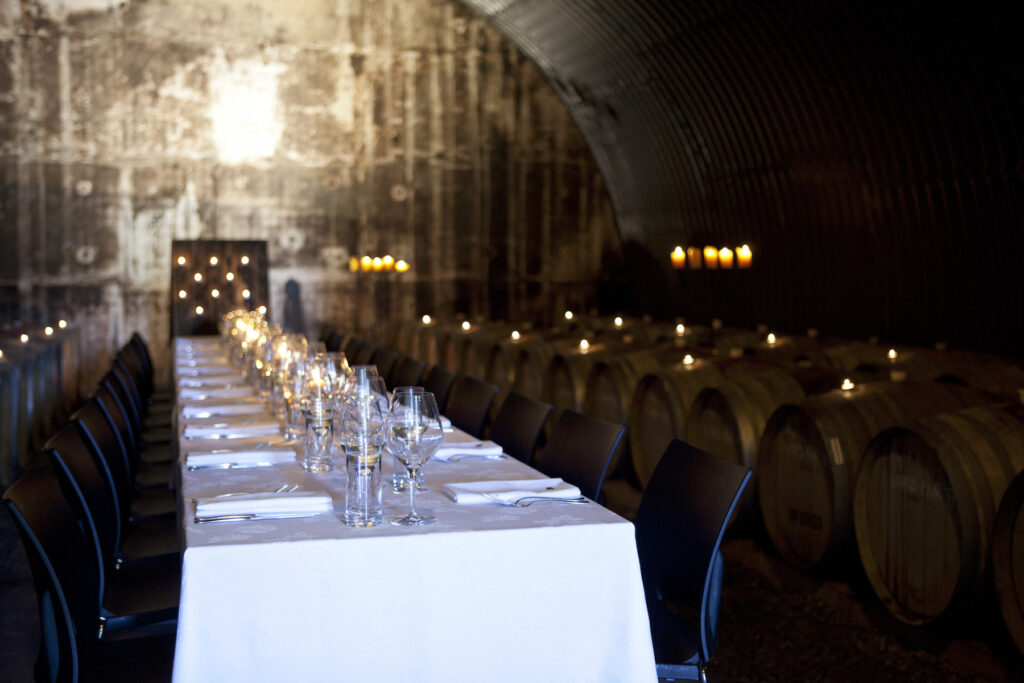
The Sauvignon has 20% fermented in seasoned barriques. 40% wild yeasts, (it is the wild yeast that has a succession of six different species)and then we have a succession of six yeasts that we use. All of the rest of the wines are 100% wild yeast. (with a range of 9 – 15 months) 9 months on lees. The key for me is we don’t use any press wine. You get a tonne of grapes and we get maybe 750 litres a tonne. As you press the grapes more, you press potassium out of the skins as well as phenolics. The pH goes up as the acid goes down and the wines become soapy. We want a wine that is subtle on the front with a nice long palate. We crop it low, pick a bit riper, so we’re about 13.4 or something like that.
We think sauvignon is a classic variety, and Jancis says that a classic variety has to age – and sauvignons do age. This one – the Boundary Farm is what I’ll drink if we’re home and cooking – something like the ’13.
We do a couple of different ones, and we often get that white peach, stone fruit type characters. We did a tasting here with Robert Joseph, and there were about forty of what we’d call ‘alternative styles’ of Sauvignon. Some of them were just done for marketing, but the serious ones that were low-cropped, and I think it’s got to be ripe to do wild ferment. Robert said it’s quite a unique/ distinctive style for New Zealand, and I tend to agree.
This is why we set up Mahi back in 2001. I’d come from working in Chile to help set up Seresin and was travelling a lot for both, and you can see that people thought Marlborough was just one big-arse vineyard. Yet you get massively different characters As a winemaker you want to do your own thing to express yourself through your wines and I had been putting off starting Mahi as I was loving where I was. My father became ill and I realised that perhaps I wouldn’t live for ever and it was time to get going!!
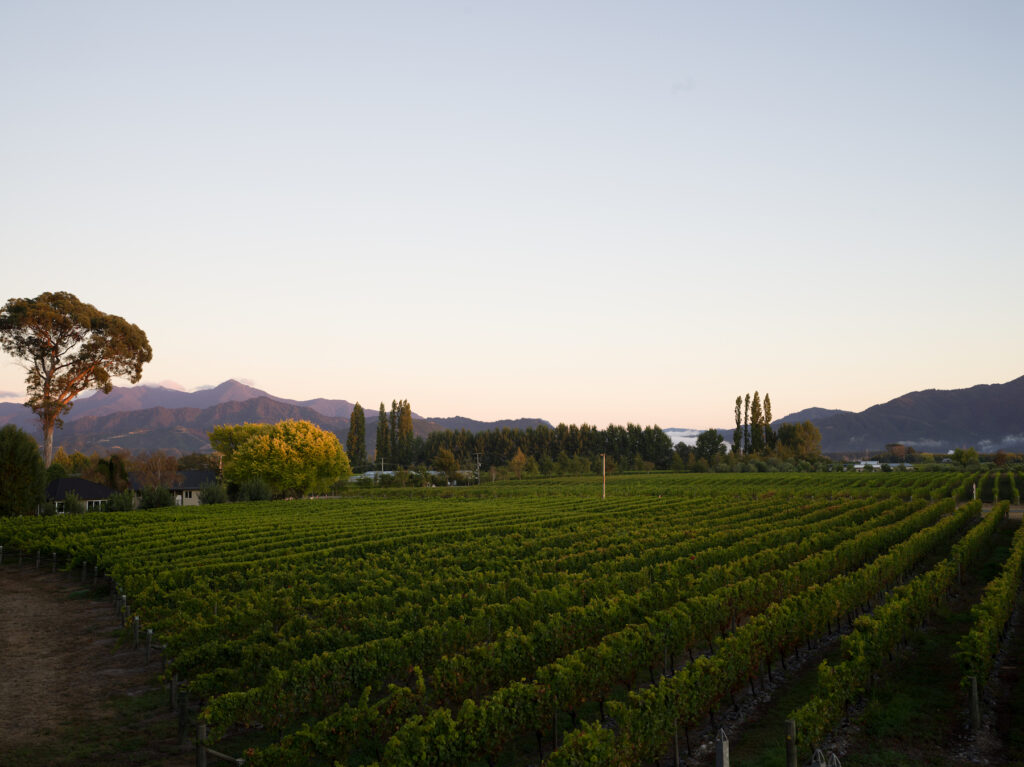
We started with one then three vineyards and I wanted to show the differences across the valley, and we bought the winery in ’06. It is the ex-Cellier Le Brun winery so was one of the first four built in Marlborough. Our Boundary Farm vineyard, with its north facing slope and all clay – you’d struggle to find a stone – and it’s warm. All hand picked, no additions, whole cluster and goes straight to barrel. So really high solids, and no sulphur and we just leave it. Stays in barrel for 11 months and then we hold it for another year before release.
WineFolio: It’s got a wonderful nose and real character. Love the texture of that too.
BB: Well if we were going to write one word for our wines, we’d write ‘texture’. Here in Marlborough we’re two degrees cooler than Burgundy in the important warm months, so it’s easy to make fruity wines.

We’ve got that lower temperature that retains the fruit character. The weird thing – and I’ve compared five regions – is we ripen Sauvignon, which is two weeks behind Chardonnay and Pinot, and, except for the small Saint Bris appellation, they don’t in Burgundy. We’ve got a long period over ten degrees Celsius, which is where the vines work. Above ten they work, below ten they don’t.
With this style when we’re doing a wine dinner, we’d do quite different foods. That first one might be lighter seafood, a vegetable dish, goats cheese, something like that. Whereas this can handle lighter white meats and that sort of thing, because it’s rich enough.
Let’s try the ’13 actually.
WF: Hmmm, that hasn’t done what I thought it would do. That’s just as fresh as a daisy. It’s changed, but not in the way I thought it would. The acidity has softened down a bit but it’s still really bright, and retained a real drive right through. I had maybe expected it to have broadened out around the middle quite a bit. But that’s still quite linear and still has real length. It’s got a more pronounced herbal, tarragon note to it than the newer one. And the skin, pithiness of an apple peel – slightly tannic.
BB: You can see where the current release can go there – the ’13, but I love the way the palate really gets integrated. I think if Marlborough picks ripe fruit that isn’t overcropped, then Sauvignon can age really well. I don’t mind a little bit of tannin, so we don’t use protein finings. I think sometimes it comes from the slightly thicker skins you get from organic vineyards, such as our Weatherall or Alias vineyards, for example and it adds to the wine
With COVID last year, no-one really knew what was going to happen, so I sold a load of fruit off, that in hindsight I should have kept. COVID’s been fairly easy on the supermarket sales area of the Marlborough wine industry, but not so much for us aiming at restaurants. Some months exports for the region to the UK have been 35% up. Anyway, so I sold on some fruit, and then we sold out of our Pinot Gris in three months. Our poor reps who’ve worked hard to get listings, and then it’s like ‘oh they’ve run out’. We’re just moving onto our ’19 Chardonnay for example. With Chardonnay being an earlier variety we’ve got it in the cooler parts of the valley like Twin Valleys, just opposite here (the Weatherall vineyard), and in the Taylor – those three. All hand picked, no additions, direct to barrel with high solids, all wild yeast and 11 months in barrel. With hand picking, normally we’d be $500 a tonne to hand pick. A machine pick is probably $70 a tonne. But this year because our crops of Chardonnay were down over 50%…$1400 a tonne!! I’ve been away for a couple of weeks, and Natalie’s been doing some work on the costs..(laughs nervously). Hand picking last year was hard because you had to keep the crews apart, but this year was just so expensive.
A whole lot of restaurants around here have closed which is a pity. Giesen sold their Cellar door; Herzog’s, a favourite, restaurants are closed; along with Allan Scotts, though they are now open again. So Wairau River is slammed – even in the week you’ve got to make a booking.
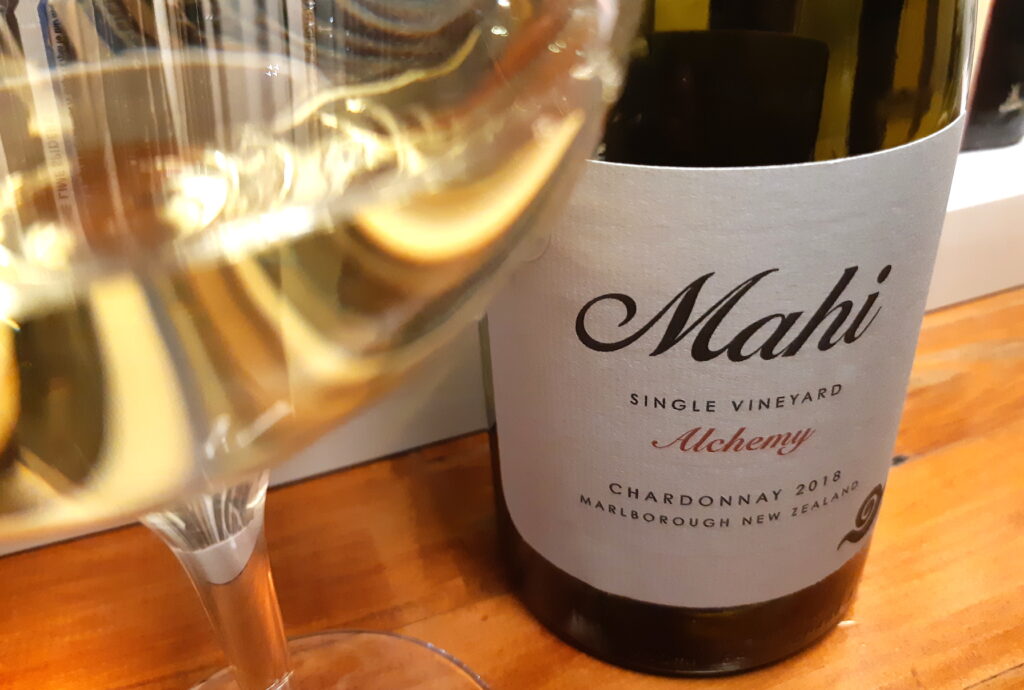
We sell more Chardonnay in New Zealand than Sauvignon. Because red+white, our distributors – nice people – have got a great portfolio with some stunning Sauvignons. Chardonnay is a real focus of ours and we have the Mahi Marlborough Chardonnay, then we’ve got two single vineyard wines, Twin Valleys and the Alchemy.
We’ll look at two single vineyards. For the Alchemy, the vineyard is Paul and Robbie Taylor, opposite Huia vineyard. Paul is a good friend and we’ve worked with that vineyard for a long time. It was organic, but organics on stony soil is hard so it is now run agrochemically.
The vineyard is clone 15, our Twin Valleys is Clone 95, we’ve got a bit of Clone 95 and Clone 1 which is the Marlborough one. Again, just hand-picked, whole cluster, straight to barrel, all wild. 15 Months and bottled unfined, unfiltered. We tend to use Mercurey barrels on this, which Marcel and Sherwyn bring in.
WF: I love the smoky intensity of that. That’s a highlight so far, so pure and concentrated. That’s the ‘Alchemy’? Lovely.
BB: ‘Twin Valleys’ Chardonnay from ’17 – from a cooler vineyard – owned by the Reeds. Clone 95, low crops, aiming at 8-10 tonnes a hectare, hand-picked. 2017 was a tough vintage, but Chardonnay was in before the three frickin’ cyclones came through. It was horrible. Having your own place made a big difference, and cropping low because at least it’s ripe. It was the weirdest vintage. Do you know, in Chile, if it rains over vintage they shit themselves. Whereas we know it’s always gonna rain over vintage, it’s just how long.. Normally it’ll rain then you’ll have three clear days, but in ’17 it just didn’t – there wasn’t a break. Paul and Robbie Taylor’s vineyard, it was one of the last that we picked, and Pat went ahead of the machine with the sprayer – with nothing in the sprayer – just blowing!!
We spend a few minutes going through some books of photographs that Brian has on the shelves by the big fireplace in the Cellar door – some great photos of people still in the wine industry, but several years (decades) younger!!
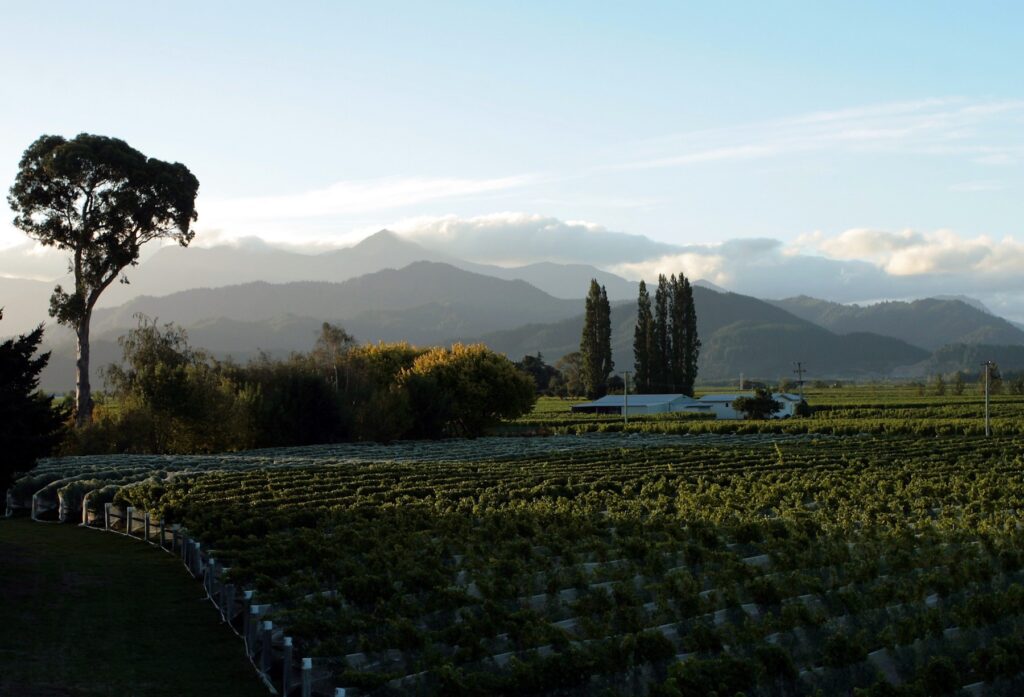
WF: Wait, do you know Nick Goldschmidt?
BB: Yes I know him well as he was at Babich before me and then at Errázuriz in Chile also so we have worked at a few similar places and catch up when he is back down this way.. It’s a really nice community around here. There are so many good people and I do love the social side of the industry. You run into people all over the world that you have worked, dined or hung out with.
It’s a funny time in the industry, because the bigger guys are getting bigger and probably more samey – some of them. When we started in ’96 with Seresin it was easy to be different. I thought ‘this is too simple’ and we were doing really well quite quickly. Then I thought over time it’s going to be harder to be different. And actually, it’s got easier! Because the big guys are doing a bigger percentage of the wines.
There’s also a real succession happening in the vineyards and wineries now, with a lot of vineyards that people have had for 20-30 years. And in a normal vintage, growers can do well. If you’re down the other end of the valley and you’re cropping at 15 tonnes a hectare let’s say, and getting $1900 a tonne. That’s $28,500 income per hectare, and it costs about $12,000 to run. Marlborough had nearly run out of wine before vintage and this has only been made worse with the small 2021 vintage, so there’s a massive land grab and big companies are buying. Also land owners are doing more leasing, so they have the land in the future. I believe there’s maybe another 3000 hectares of land to come – up the valley that way and further south. When Seresin started it was on the western edge and people thought it was crazy, now plantings go 42km further up!
(we move on to a Pinot Gris and Pinot Noir)
This Pinot Gris is all from Ward. Four different clones that we selected together with the previous owners. It was sold a couple of years ago but we still get the fruit which is great. It is our coolest site so retains great fruit notes and palate texture.
WF: For a dry style, it’s nice and rich. Got a generous core to it. I like ones like this that are rich and generous but not overly sweet. It’s a difficult trick to pull off. Obviously it’s a low acid variety and you’ve said you’re avoiding the phenolics with skin contact and so on. It’s a tricky one to avoid just being bland.
And this is our Pinot Noir which comes from three of our coolest sites and I am afraid we will probably run out this year. You know the Wine Society in England? We’ve just done a Pinot Noir for them.
We go through in late December and we take off the wing bunches, and we’re careful over the sorting table when it’s hand-picked. About 30% is fermented with the whole bunches. About 3 weeks on skins then we run it to barrel and normally 11 to 15 months, but this one tasted really good after 10 months.
Pinot from Marlborough continues to improve as people get on top of their vineyards and handle the fruit more gently. The name is growing around the world but I am worried that some will be replaced with Sauvignon, especially when the crops were so low this year.

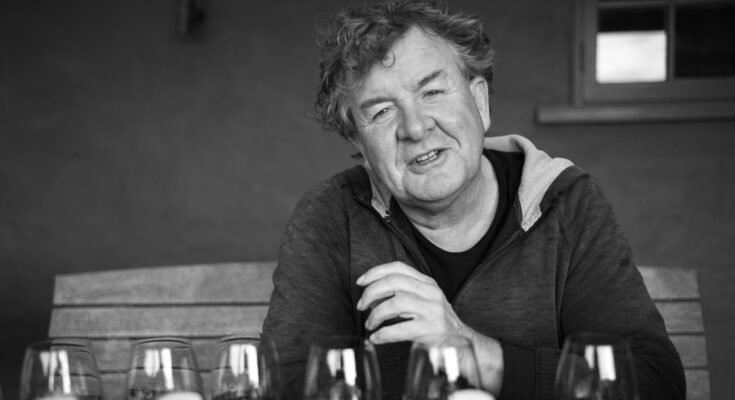
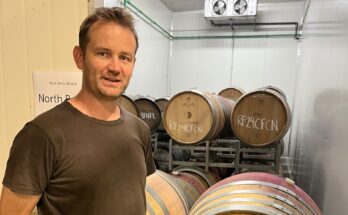


Winefolio, you really are covering some ground with amazing stories from the winemakers! Thank you for highlighting amazing NZ wines…. Really has helped my wine selection and collection.